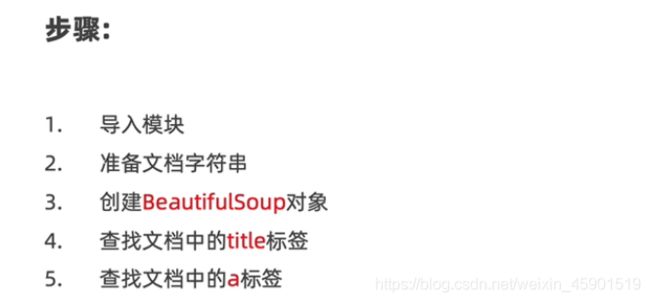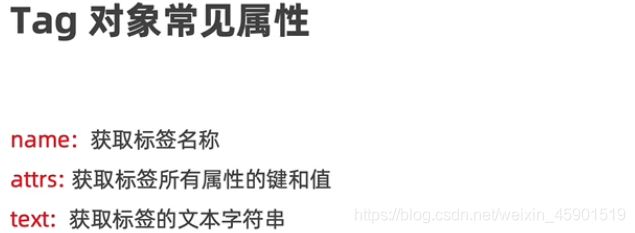适合小白的Python爬虫入门——轻松获取疫情数据
黑马程序员视频笔记(自用).
目录
- 一、基础知识
- 1、爬虫简介
- 1.1 网络爬虫与浏览器的区别
- 1.2 网络爬虫的定义
- 1.3 网络爬虫的作用
- 2、requests请求库
- 2.1 requests介绍
- 2.2 requests安装
- 2.3 requests的基本使用
- 3、Beautiful Soup解析库
- 3.1 Beautiful Soup介绍
- 3.2 Beautiful Soup安装
- 3.3 Beautiful Soup对象的介绍与创建
- 3.4 Beautiful Soup对象的find方法
- 3.5 案例:从疫情首页提取各国最新的疫情数据
- 4、正则表达式
- 4.1正则表达式的概念与作用
- (1)概念:
- (2)作用:
- 4.2 正则表达式常见语法
- 4.3 re.findall()方法
- (1)API:
- (2)findalla()的特点
- 4.4 正则表达式中r原串的使用
- 4.5 提取最新的疫情数据的json字符串
- 4.6 总结
- 5、json模块
- 5.1 json模块介绍
- 5.2 json转换为python
- 5.3 python转换为json
- (1) python类型数据转换为json字符串:
- (2)python类型数据以json格式写入文件:
- 5.4 解析最新的疫情数据的json字符串
- 5.5 总结
- 二、疫情爬虫项目
- 1、采集最近一日世界各国疫情数据
- 2、采集从01月23日以来的世界各国疫情数据
- 3、采集最近一日全国各省疫情数据
- 4、采集从01月22日以来的中国各省疫情数据
- 5、总结
一、基础知识
1、爬虫简介
1.1 网络爬虫与浏览器的区别
如下图所示,是浏览器工作的原理:发送请求——>服务器响应——>返回响应的数据,进行渲染。

而网络爬虫的工作原理是:发送请求——>服务器响应——>返回响应的数据。

1.2 网络爬虫的定义
1.3 网络爬虫的作用
那怎么请求数据呢?下面接着看:
2、requests请求库
2.1 requests介绍
2.2 requests安装
打开终端,输入下面命令:
pip install requests -i https://pypi.tuna.tsinghua.edu.cn/simple
2.3 requests的基本使用
# 1.导入模块
import requests
# 2.发送请求,获取响应
response = requests.get('http://www.baidu.com')
print(response) # 表示成功
# 3.获取响应数据
# print(response.encoding) # 查看默认使用的是什么编码:ISO-8859-1
##方式一获取响应
response.encoding = 'utf-8' # 改变编码方式
print(response.text)
##方式二获取响应(推荐)
print(response.content.decode()) # decode()默认使用utf-8解码
# print(response.content.decode(encoding='gbk')) # 改为gbk编码方式
现在数据请求到了,那怎么从请求的数据中提取想要的数据呢?接着看:
3、Beautiful Soup解析库
3.1 Beautiful Soup介绍
3.2 Beautiful Soup安装
Beautiful Soup3停止更新了,所以这里安装Beautiful Soup4,按如下命令:
pip install bs4 -i https://pypi.tuna.tsinghua.edu.cn/simple
还需要安装xml解析库:
pip install lxml -i https://pypi.tuna.tsinghua.edu.cn/simple
3.3 Beautiful Soup对象的介绍与创建
(2)创建:
# 1.导入模块
from bs4 import BeautifulSoup
# 2.创建BeautifulSoup对象
soup = BeautifulSoup('data', 'lxml') # 第一个参数:html的开始标签、数据、结束标签;第二个参数:指明要用的解析
print(soup) # BeautifulSoup会自动的修正html
3.4 Beautiful Soup对象的find方法

html文档树如下图所示:

接下来看看find方法的API:
![]()

接下来看看例子:
(1)根据标签名查找:
需求:获取文档中的title标签和a标签。
# 1.导入模块
from bs4 import BeautifulSoup
# 2.准备文档字符串
html = """
The Dormouse's story
The Dormouse's story
Once upon a time there were three little sisters; and their names were
Elsie.
Lacieand
tillie;
and they lived at the bottom of a well.
...
"""
# 3.创建BeautifulSoup对象
soup = BeautifulSoup(html, 'lxml')# 第一个参数:html的开始标签、数据、结束标签;第二个参数:指明要用的解析
# 4.查找title标签
title = soup.find('title')
print(title)
# 5.查找a标签
a = soup.find('a')
print(a) # 只是第一个
## 查找所有的a标签
a_s = soup.find_all('a') # 把所有的a标签存入列表,再返回
print(a_s)
(2)根据属性查找:
需求:获取文档中的id为link1的标签
代码:
# 1.导入模块
from bs4 import BeautifulSoup
# 2.准备文档字符串
html = """
The Dormouse's story
The Dormouse's story
Once upon a time there were three little sisters; and their names were
Elsie.
Lacieand
tillie;
and they lived at the bottom of a well.
...
"""
# 3.创建BeautifulSoup对象
soup = BeautifulSoup(html, 'lxml')
# 4.获取文档中的id为link1的标签
## 方式一:通过命名参数指定
a = soup.find(id="link1")
print(a)
# 方式二:使用attrs来指定属性字典,进行查找
a = soup.find(attrs={
'id': 'link1'})
print(a)
(3)根据文本查找(使用不多):
需求:获取文档中文本为Elsie的标签文本
代码:
# 1.导入模块
from bs4 import BeautifulSoup
# 2.准备文档字符串
html = """
The Dormouse's story
The Dormouse's story
Once upon a time there were three little sisters; and their names were
Elsie.
Lacieand
tillie;
and they lived at the bottom of a well.
...
"""
# 3.创建BeautifulSoup对象
soup = BeautifulSoup(html, 'lxml')
# 4.查找文档中文本为Elsie的标签文本
text = soup.find(text='Elsie')
print(text)
现在我们通过find方法获取到了文档中的标签,其实像上面获取的是Tag对象。接下来介绍一下Tag对象:
soup = BeautifulSoup(html, 'lxml')
a = soup.find(id="link1") # 这个a就是Tag对象
# Tag对象
print(type(a)) # 3.5 案例:从疫情首页提取各国最新的疫情数据
# 1.导入相关模块
import requests
from bs4 import BeautifulSoup
# 2.发送请求,获取疫情首页内容
response = requests.get('https://ncov.dxy.cn/ncovh5/view/pneumonia')
home_page = response.content.decode() # 默认utf-8编码
print(home_page) # 打印看是否请求成功
# 3.使用BeautifulSoup提取疫情数据
soup = BeautifulSoup(home_page, 'html5lib') # 创建BeautifulSoup对象
script = soup.find(id="getListByCountryTypeService2true") # 根据属性查找:方式一:通过命名参数指定
# script = soup.find(attrs={'id':'getListByCountryTypeService2true'}) # 根据属性查找:方式二:使用attrs来指定属性字典,进行查找
print(script)
text = script.text # 接收这个标签里的文本内容
print(text)
注意:我使用lxml解析器的时候,用text获取的内容为空,我给换成html5lib就解决了。
安装:pip install html5lib
现在想要的数据找到了,但是如何能准确的匹配呢?下面来看:
4、正则表达式
4.1正则表达式的概念与作用
(1)概念:
(2)作用:
4.2 正则表达式常见语法
# 导入正则模块
import re
# 字符模块
rs = re.findall('abc', 'abc')
rs = re.findall('a.c', 'abc')
rs = re.findall('a\.c', 'a.c') # \为转义字符
rs = re.findall('a[bc]d', 'acd') # []就是个字符集,匹配到里面的任意一个都行
# 预定义的字符集
rs = re.findall('\d', '123')
rs = re.findall('\w', 'Az123_我爱中国') # \w匹配的是大小写字母、数字、下划线、中文
# 数量词
rs = re.findall('a*', 'adc') # a*就表示出现0,1,2...n次a,
rs = re.findall('a+', 'abc') # a+表示出现1,2...n次a
rs = re.findall('a?', 'abc') # a?表示a出现0次或1次
rs = re.findall('a\d{2}', 'a123') # \d{2}表示\d出现两次
print(rs)
总结:
4.3 re.findall()方法
(1)API:
(2)findalla()的特点
import re
# 1.findall方法,返回匹配的结果列表
rs = re.findall('\d+', 'chuan13zhi24')
# print(rs)
# 2.findall方法中,flag参数的作用
rs = re.findall('a.bc', 'a\nbc') # 这个.不能匹配\n
rs = re.findall('a.bc', 'a\nbc', re.DOTALL) # 这个就可以匹配\n了
rs = re.findall('a.bc', 'a\nbc', re.S) # 作用同上
# print(rs)
# findall方法中,分组的使用
rs = re.findall('a.+bc', 'a\nbc', re.DOTALL) #
print(rs) # ['a\nbc']
rs = re.findall('a(.+)bc', 'a\nbc', re.DOTALL) # 只返回和小括号里面匹配的内容,其他的字符负责定位
print(rs) # ['\n']
4.4 正则表达式中r原串的使用
import re
# 1.不使用r原串时,与到转义字符怎么做
rs = re.findall('a\nbc', 'a\nbc')
print(rs) # ['a\nbc']
rs = re.findall('a\\bc', 'a\\bc') # 遇到转义字符不能匹配
print(rs) # []
rs = re.findall('a\\\\bc', 'a\\bc') # 这个是解决的办法,使用4个\便可解决(繁琐)
print(rs) # ['a\\bc']
#2.r原串在正则中就可以消除转义字符带来的影响
rs = re.findall(r'a\\nbc', 'a\\nbc')
print(rs) # ['a\\nbc']
# 扩展:可以解决写正则的时候,不符合PEP8规范的问题
rs = re.findall(r'\d', 'a123')
print(rs) # ['1', '2', '3']
4.5 提取最新的疫情数据的json字符串
代码:
# 1.导入相关模块
import requests
from bs4 import BeautifulSoup
import re
# 2.发送请求,获取疫情首页内容
response = requests.get('https://ncov.dxy.cn/ncovh5/view/pneumonia')
home_page = response.content.decode() # 默认utf-8编码
# print(home_page) # 打印看是否请求成功
# 3.使用BeautifulSoup提取疫情数据
soup = BeautifulSoup(home_page, 'html5lib') # 创建BeautifulSoup对象
script = soup.find(id="getListByCountryTypeService2true") # 根据属性查找:方式一:通过命名参数指定
# script = soup.find(attrs={'id':'getListByCountryTypeService2true'}) # 根据属性查找:方式二:使用attrs来指定属性字典,进行查找
# print(script)
text = script.text # 接收这个标签里的文本内容
# print(text)
# 4.使用正则表达式,提取json字符串
json_str = re.findall(r'\[.+\]', text)[0] # []有特殊用法,所以要转义
print(json_str)
4.6 总结
现在json格式的字符串取出来了,那怎么转成python的类型,进而存入文件呢?下面来看:
5、json模块
5.1 json模块介绍
5.2 json转换为python
import json
# 1.把JSON字符串转换为PYTHON数据
# 1.1 准备JSON字符串
json_str = """[{"provinceName":"美国", "currentConfirmedCount":1179041, "confirmedCount":1643499},
{"provinceName":"英国", "currentConfirmedCount":222227, "confirmedCount":259559}]"""
# 1.2 把JSON字符串转换为PYTHON数据
rs = json.loads(json_str)
print(rs)
print(type(rs)) # 5.3 python转换为json
(1) python类型数据转换为json字符串:
(2)python类型数据以json格式写入文件:
import json
# 1.把python转换为json字符串
# 1.1 python类型的数据
json_str = """[{"provinceName":"美国", "currentConfirmedCount":1179041, "confirmedCount":1643499},
{"provinceName":"英国", "currentConfirmedCount":222227, "confirmedCount":259559}]"""
rs = json.loads(json_str) # rs便是python类型的数据
# 1.2把python转换为json字符串
json_str = json.dumps(rs, ensure_ascii=False)
print(json_str)
# 2.把python以json格式存储到文件中
# 2.1 构建要写入的文件对象
with open('data/test1.json', 'w') as fp:
# 2.2 把python以json格式存储到 test1.json文件中
json.dump(rs, fp, ensure_ascii=False)
5.4 解析最新的疫情数据的json字符串
# 1.导入相关模块
import requests
from bs4 import BeautifulSoup
import re
import json
# 2.发送请求,获取疫情首页内容
response = requests.get('https://ncov.dxy.cn/ncovh5/view/pneumonia')
home_page = response.content.decode() # 默认utf-8编码
# print(home_page) # 打印看是否请求成功
# 3.使用BeautifulSoup提取疫情数据
soup = BeautifulSoup(home_page, 'html5lib') # 创建BeautifulSoup对象
script = soup.find(id="getListByCountryTypeService2true") # 根据属性查找:方式一:通过命名参数指定
# script = soup.find(attrs={'id':'getListByCountryTypeService2true'}) # 根据属性查找:方式二:使用attrs来指定属性字典,进行查找
# print(script)
text = script.text # 接收这个标签里的文本内容
# print(text)
# 4.使用正则表达式,提取json字符串
json_str = re.findall(r'\[.+\]', text)[0] # []有特殊用法,所以要转义
# print(json_str)
# 5.把json字符串转换为python类型的数据
last_day_corona_virus = json.loads(json_str)
print(last_day_corona_virus)
5.5 总结
二、疫情爬虫项目
1、采集最近一日世界各国疫情数据
import requests
from bs4 import BeautifulSoup
import re
import json
# 1.发送请求,获取疫情首页
response = requests.get('https://ncov.dxy.cn/ncovh5/view/pneumonia')
home_page = response.content.decode()
# 2.从疫情首页,提取最近一日各国疫情数据
soup = BeautifulSoup(home_page, 'html5lib')
script = soup.find(id='getListByCountryTypeService2true')
text = script.text
# print(text)
# 3.从疫情数据中获取json格式的字符串
json_str = re.findall('\[.+\]', text)[0]
# print(json_str)
# 4.把json格式的字符串转换为python类型
last_corona_virus = json.loads(json_str)
# print(last_corona_virus)
# 5.以json格式保存,最近一日各国疫情数据
with open('data/last_corona_virus.json', 'w', encoding="utf-8") as fp:
json.dump(last_corona_virus, fp, ensure_ascii=False)
2、采集从01月23日以来的世界各国疫情数据
代码:
import requests
from bs4 import BeautifulSoup
import re
import json
from tqdm import tqdm
class CoronaVirusSpider(object):
def __init__(self):
self.home_url = 'https://ncov.dxy.cn/ncovh5/view/pneumonia'
def get_content_from_url(self, url):
"""
根据URL,获取响应内容的字符串数据
:param url:请求的url
:return:响应内容的字符串
"""
response = requests.get(url)
return response.content.decode()
def parse_home_page(self, home_page):
"""
解析首页内容,获取解析后的python数据
:param home_page:首页的内容
:return:解析后的python数据
"""
# 2.从疫情首页,提取最近一日各国疫情数据
soup = BeautifulSoup(home_page, 'html5lib')
script = soup.find(id='getListByCountryTypeService2true')
text = script.text
# print(text)
# 3.从疫情数据中获取json格式的字符串
json_str = re.findall('\[.+\]', text)[0]
# print(json_str)
# 4.把json格式的字符串转换为python类型
data = json.loads(json_str)
# print(last_corona_virus)
return data
def save(self, data, path):
# 5.以json格式保存,最近一日各国疫情数据
with open(path, 'w', encoding="utf-8") as fp:
json.dump(data, fp, ensure_ascii=False)
def crawl_last_day_corona_virus(self):
"""
采集最近一天的各国疫情信息
:return:
"""
# 1.发送请求,获取首页内容
home_page = self.get_content_from_url(self.home_url)
# 2.解析首页内容,获取最近一天的疫情数据
last_day_corona_virus = self.parse_home_page(home_page)
# 3.保存数据
self.save(last_day_corona_virus, 'data/last_corona_virus.json')
def crawl_corona_virus(self):
"""
采集1月23日以来各国疫情数据
:return:
"""
# 1.加载各国疫情数据
with open('data/last_corona_virus.json', 'r', encoding='gb18030', errors='ignore') as fp:
last_day_corona_virus = json.load(fp)
# print(last_day_corona_virus)
# 定义列表,用于存储各国1月23日以来的疫情数据
corona_virus = []
# 2.遍历各国疫情数据,获取统计的URL
for country in tqdm(last_day_corona_virus, '采集1月23日以来的各国疫情数据'): # tqdm为进度条显示
# 3.发送请求,获取各国1月23号至今的json数据
statistics_data_url = country['statisticsData']
statistics_data_json_str = self.get_content_from_url(statistics_data_url)
# 4.把json数据转换为python类型数据,添加列表
statistics_data = json.loads(statistics_data_json_str)['data']
# print(statistics_data)
for one_day in statistics_data:
one_day['provinceName'] = country['provinceName']
one_day['countryShortCode'] = country['countryShortCode']
# print(statistics_data)
corona_virus.extend(statistics_data)
# 5.把列表以json格式保存为文件
self.save(corona_virus, 'data/corona_virus.json')
def run(self):
# self.crawl_last_day_corona_virus()
self.crawl_corona_virus()
if __name__ == "__main__":
spider = CoronaVirusSpider()
spider.run()
注:通过疫情首页,获取到的是最近一日的数据,在这个数据中,每一个国家有一个url,是所有时间的数据,所以通过这个url才能获取所有时间的数据。
3、采集最近一日全国各省疫情数据
代码:
import requests
from bs4 import BeautifulSoup
import re
import json
from tqdm import tqdm
class CoronaVirusSpider(object):
def __init__(self):
self.home_url = 'https://ncov.dxy.cn/ncovh5/view/pneumonia'
def get_content_from_url(self, url):
"""
根据URL,获取响应内容的字符串数据
:param url:请求的url
:return:响应内容的字符串
"""
response = requests.get(url)
return response.content.decode()
def parse_home_page(self, home_page, tag_id):
"""
解析首页内容,获取解析后的python数据
:param home_page:首页的内容
:return:解析后的python数据
"""
# 2.从疫情首页,提取最近一日各国疫情数据
soup = BeautifulSoup(home_page, 'html5lib')
script = soup.find(id=tag_id)
text = script.text
# print(text)
# 3.从疫情数据中获取json格式的字符串
json_str = re.findall('\[.+\]', text)[0]
# print(json_str)
# 4.把json格式的字符串转换为python类型
data = json.loads(json_str)
# print(last_corona_virus)
return data
def save(self, data, path):
# 5.以json格式保存,最近一日各国疫情数据
with open(path, 'w', encoding="utf-8") as fp:
json.dump(data, fp, ensure_ascii=False)
def crawl_last_day_corona_virus(self):
"""
采集最近一天的各国疫情信息
:return:
"""
# 1.发送请求,获取首页内容
home_page = self.get_content_from_url(self.home_url)
# 2.解析首页内容,获取最近一天的疫情数据
last_day_corona_virus = self.parse_home_page(home_page, tag_id='getListByCountryTypeService2true')
# 3.保存数据
self.save(last_day_corona_virus, 'data/last_corona_virus.json')
def crawl_corona_virus(self):
"""
采集1月23日以来各国疫情数据
:return:
"""
# 1.加载各国疫情数据
with open('data/last_corona_virus.json', 'r', encoding='gb18030', errors='ignore') as fp:
last_day_corona_virus = json.load(fp)
# print(last_day_corona_virus)
# 定义列表,用于存储各国1月23日以来的疫情数据
corona_virus = []
# 2.遍历各国疫情数据,获取统计的URL
for country in tqdm(last_day_corona_virus, '采集1月23日以来的各国疫情数据'): # tqdm为进度条显示
# 3.发送请求,获取各国1月23号至今的json数据
statistics_data_url = country['statisticsData']
statistics_data_json_str = self.get_content_from_url(statistics_data_url)
# 4.把json数据转换为python类型数据,添加列表
statistics_data = json.loads(statistics_data_json_str)['data']
# print(statistics_data)
for one_day in statistics_data:
one_day['provinceName'] = country['provinceName']
one_day['countryShortCode'] = country['countryShortCode']
# print(statistics_data)
corona_virus.extend(statistics_data)
# 5.把列表以json格式保存为文件
self.save(corona_virus, 'data/corona_virus.json')
def crawl_last_day_corona_virus_of_china(self):
"""
采集最近一日各省疫情数据
:return:
"""
# 1.发送请求,获取疫情首页
home_page = self.get_content_from_url(self.home_url)
# 2.解析疫情首页,获取最近一日各省疫情数据
last_day_corona_virus_of_china = self.parse_home_page(home_page, tag_id='getAreaStat')
# 3.保存疫情数据
self.save(last_day_corona_virus_of_china, 'data/last_day_corona_virus_of_china.json')
def run(self):
self.crawl_last_day_corona_virus()
# self.crawl_corona_virus()
self.crawl_last_day_corona_virus_of_china()
if __name__ == "__main__":
spider = CoronaVirusSpider()
spider.run()
4、采集从01月22日以来的中国各省疫情数据
代码:
import requests
from bs4 import BeautifulSoup
import re
import json
from tqdm import tqdm
class CoronaVirusSpider(object):
def __init__(self):
self.home_url = 'https://ncov.dxy.cn/ncovh5/view/pneumonia'
def get_content_from_url(self, url):
"""
根据URL,获取响应内容的字符串数据
:param url:请求的url
:return:响应内容的字符串
"""
response = requests.get(url)
return response.content.decode()
def parse_home_page(self, home_page, tag_id):
"""
解析首页内容,获取解析后的python数据
:param home_page:首页的内容
:return:解析后的python数据
"""
# 2.从疫情首页,提取最近一日各国疫情数据
soup = BeautifulSoup(home_page, 'html5lib')
script = soup.find(id=tag_id)
text = script.text
# print(text)
# 3.从疫情数据中获取json格式的字符串
json_str = re.findall('\[.+\]', text)[0]
# print(json_str)
# 4.把json格式的字符串转换为python类型
data = json.loads(json_str)
# print(last_corona_virus)
return data
def parse_corona_virus(self, last_day_corona_virus_of_china, desc):
# 定义列表,用于存储各国1月23日以来的疫情数据
corona_virus = []
# 2.遍历最近一日全国疫情信息,获取各省疫情URL
for country in tqdm(last_day_corona_virus_of_china, desc): # tqdm为进度条显示
# 3.发送请求,过去各省疫情json字符串
statistics_data_url = country['statisticsData']
statistics_data_json_str = self.get_content_from_url(statistics_data_url)
# 4.解析各省疫情json字符串,并添加列表
statistics_data = json.loads(statistics_data_json_str)['data']
# print(statistics_data)
for one_day in statistics_data:
one_day['provinceName'] = country['provinceName']
if country.get('countryShortCode'):
one_day['countryShortCode'] = country['countryShortCode']
# print(statistics_data)
corona_virus.extend(statistics_data)
return corona_virus
def load(self, path):
"""
根据路径加载数据
"""
with open(path, 'r', encoding='gb18030', errors='ignore') as fp:
data = json.load(fp)
return data
def save(self, data, path):
# 5.以json格式保存,最近一日各国疫情数据
with open(path, 'w', encoding="utf-8") as fp:
json.dump(data, fp, ensure_ascii=False)
def crawl_last_day_corona_virus(self):
"""
采集最近一天的各国疫情信息
:return:
"""
# 1.发送请求,获取首页内容
home_page = self.get_content_from_url(self.home_url)
# 2.解析首页内容,获取最近一天的疫情数据
last_day_corona_virus = self.parse_home_page(home_page, tag_id='getListByCountryTypeService2true')
# 3.保存数据
self.save(last_day_corona_virus, 'data/last_corona_virus.json')
def crawl_corona_virus(self):
"""
采集1月23日以来各国疫情数据
:return:
"""
# 1.加载各国疫情数据
last_day_corona_virus = self.load('data/last_corona_virus.json')
# print(last_day_corona_virus)
# 定义列表,用于存储各国1月23日以来的疫情数据
corona_virus = self.parse_corona_virus(last_day_corona_virus, '采集1月23日以来的各国疫情数据')
# 5.把列表以json格式保存为文件
self.save(corona_virus, 'data/corona_virus.json')
def crawl_last_day_corona_virus_of_china(self):
"""
采集最近一日各省疫情数据
:return:
"""
# 1.发送请求,获取疫情首页
home_page = self.get_content_from_url(self.home_url)
# 2.解析疫情首页,获取最近一日各省疫情数据
last_day_corona_virus_of_china = self.parse_home_page(home_page, tag_id='getAreaStat')
# 3.保存疫情数据
self.save(last_day_corona_virus_of_china, 'data/last_day_corona_virus_of_china.json')
def crawl_corona_virus_of_china(self):
"""
采集从1月22日以来的全国各省的疫情数据
:return:
"""
# 1.加载最近一日全国疫情信息
last_day_corona_virus_of_china = self.load('data/last_day_corona_virus_of_china.json')
corona_virus = self.parse_corona_virus(last_day_corona_virus_of_china, '采集1月23日以来的各省疫情数据')
# 5.以json格式保存疫情信息
self.save(corona_virus, 'data/corona_virus_of_china.json')
def run(self):
# self.crawl_last_day_corona_virus()
self.crawl_corona_virus()
# self.crawl_last_day_corona_virus_of_china()
self.crawl_corona_virus_of_china()
if __name__ == "__main__":
spider = CoronaVirusSpider()
spider.run()




































